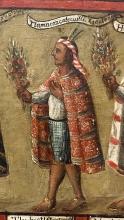tlamacazqui (Azca12)
This black-line drawing of the iconography for tlamacazqui (a type of priest) shows a seated man in profile, facing toward the viewer's right. We know from the gloss that this man is a Mexica (i.e., affiliated with the city of Mexico). He has his knees up under his chin, and his hairstyle is somewhat different from the average male, in that the top part is combed forward and there is a curl at the front. On his back he carries a bird facing upward, held in a cloth bundle tied at the man's throat. The bird is large, emerging with its beak reaching up just above the man's head. The tail of the bird protrudes from below the cloth that holds him, reaching down and away from the man's rear end.
Stephanie Wood
Could the bird be a hummingbird, even if it is exceptionally large when compared to the size of the man carrying it? Michel Graulich suggests this in his publication of the Codex Azcatitlan (1995, v. 1, p. 66.). As the gloss indicates, the context here includes two priests (tlamacazque). The other tlamacazqui is obscured somewhat by the archival stamp. This double presentation of priests may explain the reduplication of the tla- in the gloss.
Stephanie Wood
tlatlamacazqueinmexica
tlatlamacazque in Mexica
Stephanie Wood
post-1550, possibly from the early seventeenth century
Jeff Haskett-Wood
sacerdotes, bultos, pájaros, religión
This detail comes from a large, eighteenth-century oil painting, El Bautizo de Ixtlilxochitl de Texcoco, previously known as El Bautizo de la nobleza tlaxcalteca and El Bautizo de Cuauhtémoc. The detail features someone with the title Tlamacazcatecuitli [or Tlamacazcatecuhtli] Xicotencatl. It is included here to show evidence of a memory of a title similar to tlamacazqui, which appears above. Museo Nacional de Historia, Chapultepec Park, Mexico City. Photo by S. Wood, 29 April 2025.
tlamacaz(qui), a type of priest, https://nahuatl.wired-humanities.org/content/tlamacazqui
James Lockhart (The Nahuas, 1992, 120) refers to a name (Teuctlamacazqui), witnessed in a census from the Cuernavaca region (1535–45) in the category "martial and religious."
un tipo de sacerdote
The Codex Azcatitlan is also known as the Histoire mexicaine, [Manuscrit] Mexicain 59–64. It is housed in the Bibliothèque Nationale de France, and hosted on line by the World Digital Library and the Library of Congress.
https://www.loc.gov/resource/gdcwdl.wdl_15280/?sp=12&st=image
The Library of Congress is “unaware of any copyright or other restrictions in the World Digital Library Collection.” But please cite Bibliothèque Nationale de France and this Visual Lexicon of Aztec Hieroglyphs.



